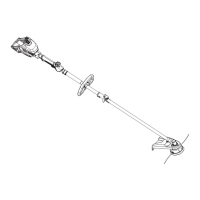12
4. Do not abuse the charger cord. Never use the cord for carrying, pulling or
unplugging the charger. Keep cord away from heat, oil, sharp edges or moving
parts. Damaged or entangled cords increase the risk of electric shock.
5. Make sure the charger cord is located so that it will not be stepped on, tripped
over, or otherwise subjected to damage or stress.
6. Keep the battery charger clean. Contamination may increase the risk of electric
shock.
7. Protect the battery charger from rain and moisture. The penetration of water in a
battery charger increases the risk of electric shock.
8. Do not operate the battery charger on easily inflammable surfaces (e.g. paper,
textiles, etc.) or in combustible environments. There is danger of fire due to the
heating of the battery charger during charging.
9. The temperature range over which the battery pack can be charged is typically
5 ˚C / 41 ˚F - 45 ˚C / 113 ˚F. Therefore, charging eorts outside the prescribed
temperature range may automatically be blocked by the protection circuitry
of the battery pack. Longest life and best performance can be obtained if the
battery pack is charged under normal conditions.
10. Disconnect charger from the power supply when not in use. This will reduce the
risk of electric shock or damage to the charger if metal items should fall into the
opening.
11. The charger is for indoor use only.
Special operation safety for the battery pack
1. The Li-ion battery pack is not fully charged at the factory. You must fully charge
it before first use.
2. The battery pack should be recharged when it fails to produce sucient power
on jobs which were easily done previously. DO NOT CONTINUE using product
with its battery in a depleted condition.
3. Do not charge the battery in an air temperature below 5 ˚C / 41 ˚F or above
45 ˚C / 113 ˚F. This is important and will prevent serious damage to the battery.
Longest life and best performance can be obtained if the battery is charged
when air temperature is about 20 ˚C / 68 ˚F. Do not store batteries in a garage or
shed over the winter as it will damage battery life.
4. When the machine continues to be used and the battery temperature is above
45 ˚C / 113 ˚F, the battery cannot be charged, even if you connect it to the
charger. Let the machine cool for some time and wait for the temperature to go
down. It can then be charged again.
5. Protect the battery pack against heat, e.g. including against continuous sun
irradiation and fire. There is a danger of explosion.

